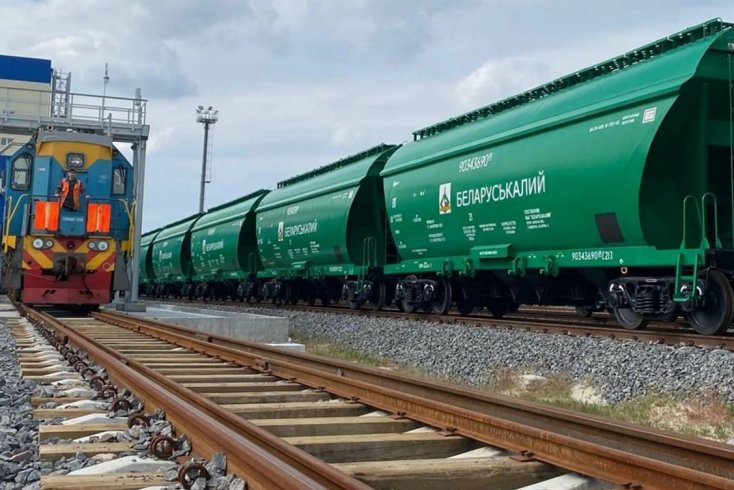By Aleś Hudzija
Dizzy with success claimed in 2023, officials hoping for similar economic performance this year. But not everyone is optimistic.

The government is expecting the economy to grow by 3.8 percent. The target is adjusted for inflation, which, according to officials, should not exceed 6 percent.
Last year, Prime Minister Raman Hałoŭčanka’s cabinet reported an increase in gross domestic product (GDP) of 3.9%, but many observers doubt robust growth is possible this year.
Meeting economic growth targets was a condition set by Alaksandar Łukašenka for Prime Minister Hałoŭčanka to stay in office. No such condition has been set for this year, just yet.
The declared growth targets are wishful thinking, based on assessments by independent Belarusian and foreign experts.
Economic outlook
Government – blue, ADB – purple, BEROC – yellow, IMF – orange, World Bank – red
IMF
After having dealt successfully with the challenges of the pandemic and the energy price shock triggered by Russia’s war in Ukraine, Europe faces the difficult task of restoring price stability while securing strong and green growth over the longer term, said the International Monetary Fund (IMF) in the regional economic outlook published in November.
Growth in the region overall is expected to improve to 1.5 percent in 2024, and may accelerate to 2.1 percent in 2025. The IMF forecasts that the near-term outlook for the European economy will be shaped by opposing trends – a tightening of macroeconomic policies and a recovery in real incomes, accompanied by falling inflation and rising wages.
For the Belarusian economy, the IMF expects growth of 1.3 percent in 2024 and only 0.6 percent in 2025. Compared to the previous outlook of April 2023, the estimates for 2024 have been revised upward by 0.1 percent, but for 2025 they have been revised downward by 0.4 percent.
The IMF forecasts that Belarus will grow slower than the region as a whole, much slower than most neighboring countries.
For example, in 2024 and 2025, Poland is expected to grow by 2.3 percent and 3.4 percent, Lithuania by 2.7 percent and 2.6 percent, and Latvia’s by 2.6 percent and 3.2 percent, respectively.
World Bank
The World Bank’s economic outlook for Europe and Central Asia, released in October, highlights that the economy continues to be negatively impacted by Russia’s invasion of Ukraine, tighter global financial conditions, sticky inflation and global economic fragmentation.
The World Bank expects global growth in 2020-2024 to be at its weakest in three decades, reflecting a weak recovery in China and a sharp slowdown in the euro area.
In 2024, the global economy is expected to grow by 2.1 percent, advanced economies, by 0.9 percent, and emerging markets and developing economies, by a more impressive 3.9 percent.
As for Belarus, the bank forecasts growth of 0.8 percent in 2024 and 0.7 percent in 2025. In January, the World Bank upgraded its 2025 forecast for Belarus to 0.8 percent.
“While the economy redirects toward the East following the imposition of sanctions
and the recession of 2022, the economic prospects appear dim,” it says. “Recent macroeconomic stability masks deep-rooted inefficiencies and growing reliance on one partner.”
A full recovery from the 2022 downturn is not expected until 2024-25.
“In the medium term, growth is anticipated to remain below potential, with domestic demand substantially curtailed due to diminished foreign exchange earnings and projected tighter monetary and fiscal policies,” the bank says.
Excepting sectors aligned with Russian exports (oil, fertilizers, and machinery), investments are projected to decelerate as the economy remains insulated.
Inflation is forecasted to stabilize at 8.2 percent, with a gradual decline to 7.2 percent expected by 2025 if administrative measures are effectively maintained.
Eurasian Development Bank
The Eurasian Development Bank, in its Macroeconomic Outlook 2024-2026 released on December 14, expects Belarus’ growth to slow down to 2 percent in 2024, provided that production and logistics chains remain in place and the government continues its favorable economic policies. The bank expects high domestic demand to be a key factor contributing to a rise inflation from 5.2 percent in 2023 to 8 percent in 2024.
EDB experts acknowledge that last year the Belarusian economy showed that it is capable of high adapting successfully to unfavorable circumstances.
“The country’s GDP grew by 3.8% YoY in the first ten months of 2023, a recovery after a 4.7% decline in 2022, partially driven by building alternative supply chains, switching to new markets, and increasing demand in Russia,” it said. “Accommodative domestic economic policy has encouraged the expansion of output, in particular, through easing lending conditions and increasing budget expenditures.”
However, Belarus’ economic growth is projected to slow in 2025-2026. “The slowdown in GDP growth in the medium term will help the economy to return to a balanced growth trajectory after overheating in 2023–2024.”
Growth of Belarus’s potential GDP will be capped at 1%–1.5% per year due to unfavorable demographic trends and restricted access to technology.
BEROC
Experts at BEROC, Belarus’ leading economic think-tank, predict that the Belarusian economy will face a significant slowdown in 2024, accompanied by rising inflation. They forecast growth of 1.6 percent.
BEROC expects a slowdown in domestic demand and consumer activity in 2024. According to the think-tank, the government will support investment through non-market tools and soft monetary policy, but the positive impact of these measures will be offset by labor shortages and an unfavorable business environment.
BEROC predicts that imports will become particularly important in the future, overshadowing domestic production. Belarusian exports will depend directly on the demand of the Russian military industry and the sustainability of supply of Belarusian goods via the Russian logistics infrastructure.
Dependence on Russia and China
Contrary to independent experts, the Belarusian government is overly optimistic.
Optimistic forecasts are typical of most governments, whether in democratic or non-democratic countries, in market or planned economies.
Forecasts should take into account realistic possibilities and be based on reliable growth drivers. In the case of Belarus, there are doubts about both. Under the current conditions, the annual growth potential is realistically estimated at 1.5 percent on condition that the country is not exposed to major shocks.
The Russian economy, increasingly dependent on China, is becoming the main pillar of the Belarusian economy. The Chinese economy is slowing down and accumulating imbalances, while Russia has been hit by Western sanctions. Despite their limited effect, the restrictions hurt the Russian economy.
Taking into account all these factors, even the conservative low growth forecasts for Belarus are very unreliable. The Belarusian economy is fragile because it is heavily dependent on Russia and China.



